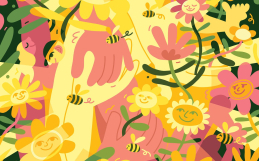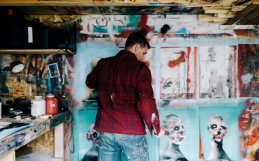An interview with Karen George: How to make it as a professional artist.
By Rachael Stone
At the Square Club art gallery, we are passionate about giving a platform to local talent, whether they are new to the scene or established artists. The advice of other creators who have found success can be invaluable to up-and-coming newbies, which is why I’ve spoken with Karen George, full-time painter of 14 years and the artist behind our current Wild Escapes exhibition, to gain her insight into garnering positive commercial results in the art world.
What advice would you give to new artists getting started in the industry? What helped you at the beginning of your career?
“Enjoy what you do. Anything worth building takes time and effort”. It’s not enough to just be good at art, you also need to have the motivation to continually produce pieces, develop as an artist, and have clear goals in mind. One suggestion Karen George makes is to remain realistic about areas for improvement, she says “It’s good to be honest with yourself and identify areas of strengths and weaknesses, so you can play on those strengths and then learn to overcome your weaknesses.” If you’re confident and comfortable about what is holding you back artistically you can be proactive about what steps you need to take to refine your work.
Another aspect of this is being clear about what your priorities are. As George puts it “do you want gallery representation? What sort of income are you after? What type of art do you want to create? It helps to define the steps and direction you need to take.” While some may be lucky enough to spend their days at the easel without worrying about income, for most of us, ensuring we can follow our passion and continue to earn a livelihood at the same time is at the forefront of our decision making. Even if you do make a few good sales, stability is key. At an amateur level, a period of lack of motivation is no more than a minor annoyance, but once art becomes a business creative blocks can be detrimental. For this reason, it is important to understand the difference between art as a deeply personal and expressive pursuit, and art as a feasible career.
How do you remain consistent and tackle creative blocks?
A lack of inspiration is a common concern for individuals who have made the move into a creative profession. We’ve all heard of musicians ‘second-album syndrome’, where once bands release their first hit they struggle to recreate the same results a second time around, but the same is also true for anyone who has had their first taste of artistic success and now has the task of producing something just as good but to a deadline. This is only worsened when art becomes your main source of earning, and so not being in the mood to paint is no longer an option. For this reason, it’s important for artists looking to go pro to have clear strategies for overcoming creative blocks when they arise. For Karen George it’s all about changing things up and experiencing new things. Spending time outside in nature, working in sketchbooks to give yourself room to experiment, even changing the layout of your studio space are all recommendations George makes to mix things up. Change is the key to inspiration, so don’t let yourself stagnate too much. It can also help to take in other works of art, whether from your own archive or the portfolio of others. You never know what technique or style you might find that you’d like to try out. “Visiting exhibitions and other art events can be inspiring and keeps you mentally fresh,” says George.
Another great way to try new styles and meet other creatives is to attend artist workshops. It’s easy to get comfortable using one technique but in order to grow as an artist it’s important to continue developing throughout your career. Karen George herself runs a number of these classes, with titles such as ‘dive into collage’, ‘building the layers’, and ‘sketchbook to paintings’, George hopes to inspire artists to branch out into new techniques. Whether you are a beginner who has attempted some sketches but not yet graduated to paint or a painter who wants to try out mixed media, George’s workshops truly capture her ‘embracing change’ approach to art, as she puts it herself “I’ve had professional artists through to complete beginners and all have enjoyed the workshops and gone away with skills they can take forward. Many return for another workshop!”. George’s workshops also allow you to try new art forms without having to invest in all new art supplies, as the materials are included making it a cost effective solution to experimentation.
How else can I build my network?
Another of Karen George’s recommendations is “working alongside other artists or taking time out to learn from another artist and help find ways to work creatively.” Developing your style isn’t the only benefit of spending more time in creative spaces. Surrounding yourself with other artists can be a great way to increase your motivation for a number of reasons, as George puts it “Gather a supportive group of artists around you that you can network with and gain support from”. Having a support system of people who understand your industry is not only great for your work, but for your mental health too, and while some may romanticize the image of the tortured artist, realistically it is unlikely you are going to produce quality work when you are unfulfilled and stressed elsewhere in your life. “There are a number of artist membership groups and podcasts out there that give lots of advice and support.”.
As a club, we couldn’t agree more! We’re members only, which means you are guaranteed to be in the company of others who share your creative concerns.
George also points out how encouraging it can be to see others succeed in the industry. “Artists tend to influence me by giving me motivation…” She says, “…if they can do it then so can I.” Here at the square club we’ve showcased all sorts of artists who have gone on to gain massive achievements following their time with us (you can have a look at our previous exhibitions here) so we’re no strangers to seeing our members flourish. Seeing is believing when it comes to making it as an artist, so surrounding yourself with the right people works wonders to remind you that hard work can pay off!
Finally, building a strong network means that you have someone to keep you on track. For most, creating new artworks is an independent pursuit therefore you don’t necessarily get the same level of social interaction as you would working in an office and this can often be detrimental to productivity. In one 2019 study published in the journal of psychology, it was found that almost all participants who shared their work with a supervisor achieved better results than those who didn’t, but this can be difficult to do when you are self-employed. “Team up with a couple of artists for accountability chats to keep on track” George suggests, that way you have a deadline to aim for and are less likely to get distracted.
We have been delighted to host your work at the square club art gallery this summer, how have you found it?
“I hadn’t appreciated that there was so much space available and I am delighted with the setting for my work plus the promotion from Sophie.“
As a private members club many may be unaware of the diversity of art we showcase, or the number of rooms available to exhibit art within, including our secret garden terrace which is currently home to the work of sculptor Sophie Howard, our lower deck cocktail bar, square kitchen restaurant and informal lounge – there is an area for any art style. An exhibition at the square club also comes with the added benefit of complimentary promotion from our dedicated community host team, something which all of our artists, including Karen George appreciate greatly.
For more information on Karen’s upcoming exhibition, workshops, and art trails please visit karengeorgeart.co.uk. Details on future exhibitions and workshops being held at the square club art gallery can be found at stage.thesquareclub.com/square-gallery/











